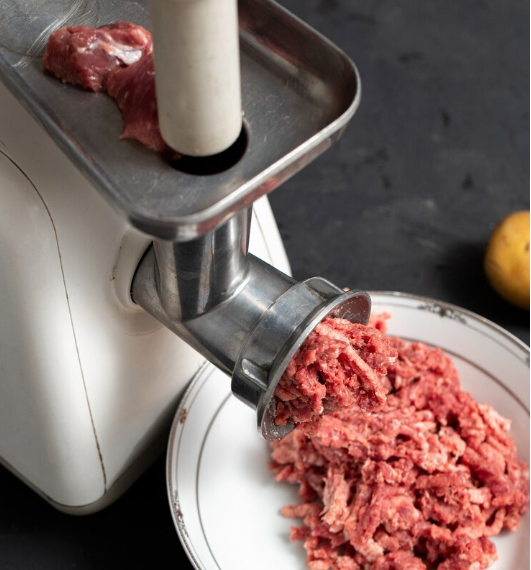Meat grinders are invaluable tools in both commercial and home kitchens, offering the ability to transform whole cuts of meat into versatile ground products. This capability opens up a world of culinary possibilities, from homemade sausages and burgers to finely ground meat for sauces and fillings. In this article, we’ll explore the different types of meat grinders, their features, benefits, and tips for selecting and maintaining one, providing a comprehensive guide for anyone considering this useful kitchen appliance.
Types of Meat Grinders
There are two main types of meat grinders: manual and electric. Each type has its own set of advantages, depending on the user’s needs and preferences. Manual meat grinders are operated by hand, using a crank to grind the meat. These grinders are typically smaller and more affordable, making them ideal for occasional use or for those who enjoy a hands-on approach to food preparation. They are also portable and do not require electricity, which can be a benefit in situations where power is unavailable. On the other hand, electric meat grinders use a motor to automate the grinding process. These models are more powerful and efficient, capable of grinding larger quantities of meat in a shorter amount of time. Electric grinders are perfect for frequent use and for those who need to process large amounts of meat quickly. They often come with multiple speed settings and additional attachments for various grinding tasks.
Key Features of Meat Grinders
When selecting a meat grinder, several key features should be considered to ensure it meets your needs. The grinding capacity, which refers to the amount of meat a grinder can process in a given time, is a crucial factor. For home use, a grinder with a capacity of around 1-2 pounds per minute is usually sufficient, while commercial use may require higher capacity models. The quality of materials used in the grinder’s construction is essential for its durability and performance. Stainless steel is often preferred for its strength, resistance to corrosion, and ease of cleaning. Additionally, many grinders come with various attachments, such as different sized grinding plates, sausage stuffing tubes, and kibbe attachments, enhancing the grinder’s versatility.
Ease of use and cleaning is another important consideration. User-friendly designs with clear instructions make grinders easier to operate, and models that are easy to disassemble with dishwasher-safe parts simplify the cleaning process. Safety features such as non-slip feet, overload protection, and secure locking mechanisms ensure safe operation, especially with electric grinders.
Benefits of Using a Meat Grinder
The benefits of using a meat grinder are numerous, making it a worthwhile investment for many kitchens. Grinding your own meat allows you to control the quality and freshness of the ingredients. You can select the specific cuts of meat and avoid the fillers and additives often found in pre-packaged ground meat. Additionally, purchasing whole cuts of meat and grinding them at home can be more economical than buying pre-ground meat, which is particularly true for larger families or those who frequently prepare ground meat dishes. A meat grinder also opens up a world of culinary possibilities, from creating custom sausage blends to experimenting with different types of meat and seasonings, allowing for greater creativity in the kitchen. Freshly ground meat has a superior texture and flavor compared to store-bought ground meat, which is especially noticeable in dishes like burgers and sausages. Furthermore, by grinding your own meat, you can reduce your intake of processed foods and control the fat content, leading to healthier meals tailored to your dietary preferences and needs.
Tips for Selecting and Maintaining a Meat Grinder
To get the most out of your meat grinder, it’s important to choose the right model and maintain it properly. When selecting a meat grinder, consider your needs and how often you plan to use it. For occasional use, a manual grinder may suffice, while frequent or heavy-duty use may warrant an electric grinder with a powerful motor and high grinding capacity. Regular cleaning is essential to maintain hygiene and ensure the grinder’s longevity. After each use, disassemble the grinder and wash all parts thoroughly with warm, soapy water, drying the parts completely before reassembling to prevent rusting. Periodically check and sharpen the grinder’s blades to ensure efficient grinding, as dull blades can make the grinding process more difficult and affect the texture of the meat. Lubricate moving parts as recommended by the manufacturer to keep the grinder operating smoothly.
Meat grinders are versatile and valuable additions to any kitchen, offering numerous benefits from improved quality control to enhanced culinary creativity. Whether you opt for a manual or electric model, selecting the right meat grinder involves considering factors such as grinding capacity, materials, attachments, and ease of use. Proper maintenance, including regular cleaning and blade sharpening, will ensure your grinder remains in top condition for years to come. For those involved in the foodservice industry, investing in a high-quality meat grinder is crucial, as it can significantly enhance the efficiency and quality of food preparation. This is particularly true when integrated with other essential restaurant equipment, ensuring that your kitchen is well-equipped to meet the demands of a busy service while maintaining high standards of food quality and safety.
















